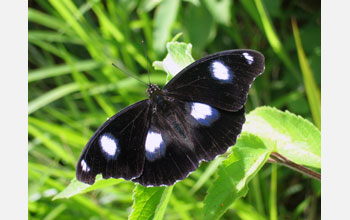Multimedia Gallery
Hypolimnas Bolina, Male
Hypolimnas Bolina, Male
A male Hypolimnas bolina, also called the Blue Moon or Great Eggfly butterfly. A highly invasive, male-killing bacteria has led to skewed sex ratios in populations of H. bolina in the South Pacific, but researchers have found that male butterflies on some islands have bounced back, thanks to the rise of a suppressor gene. (Date of Image: 2005-2006) [See Related Image.]
More about this Image
When researchers first began surveying the Blue Moon butterfly species in 2001 on the Samoan islands of Upolu and Savii, males made up only 1 percent of the population. But in 2006, after an increase in reports of male sightings at Upolu, the researchers decided to embark on a new study.
In the lab, they hatched eggs from 14 females and confirmed that the male offspring from this group were surviving with sex ratios near parity. Within 10 generations that spanned less than a year, the proportion of the male Blue Moon butterflies on Savaii jumped from 1 percent at the beginning of 2006, to about 39 percent of the 54 butterflies collected by the end of the year. This comeback is credited to the rise of a suppressor gene that holds the Wolbachia bacteria in check. Wolbachia is passed down from the mother and selectively kills males before they have a chance to hatch. The suppressor gene allows infected females to produce males. These males will mate with many, many females, and the suppressor gene will therefore be in more and more individuals over generations.
The researchers tested for the continued presence of Wolbachia in the butterflies. By mating infected females with males from a different island that did not have the suppressor gene, they also confirmed that the bacteria were still effective at killing male embryos. The male-killing ability of the bacteria emerged again after three generations. Thus, they could rule out a change in the bacteria as an explanation for the resurgence of the males in the butterfly populations studied.
Sylvain Charlat, lead author of the study and a postdoctoral researcher with joint appointments at the University of California, Berkeley, and University College London, says, "To my knowledge, this is the fastest evolutionary change that has ever been observed."
Charlat worked with Gregory Hurst, a reader in evolutionary genetics at University College London and senior author of the study. It was Hurst and colleagues who first identified Wolbachia bacteria as the cause of the distorted sex ratio. "We usually think of natural selection as acting slowly, over hundreds or thousands of years," said Hurst. "But the example in this study happened in a blink of the eye, in terms of evolutionary time, and is a remarkable thing to get to observe."
The researchers' findings are described in the July 13, 2007, issue of the journal Science. The fieldwork for the study was based out of the University of California, Berkeley, Richard B. Gump South Pacific Research Station on the island of Moorea in French Polynesia. The Gump station is part of the Moorea Coral Reef Long Term Ecological Research Site, one of 26 sites funded by the National Science Foundation to study long-term ecological phenomena.
The Blue Moon butterfly study was supported by National Science Foundation grant DEB 04-16268, "Evolutionary Impact of Cytoplasmic Sex Ratio Distorters on Host Reproductive Biology."
Credit: Photo by Sylvain Charlat
Images and other media in the National Science Foundation Multimedia Gallery are available for use in print and electronic material by NSF employees, members of the media, university staff, teachers and the general public. All media in the gallery are intended for personal, educational and nonprofit/non-commercial use only.
Images credited to the National Science Foundation, a federal agency, are in the public domain. The images were created by employees of the United States Government as part of their official duties or prepared by contractors as "works for hire" for NSF. You may freely use NSF-credited images and, at your discretion, credit NSF with a "Courtesy: National Science Foundation" notation.
Additional information about general usage can be found in Conditions.
Also Available:
Download the high-resolution JPG version of the image. (2.6 MB)
Use your mouse to right-click (Mac users may need to Ctrl-click) the link above and choose the option that will save the file or target to your computer.

